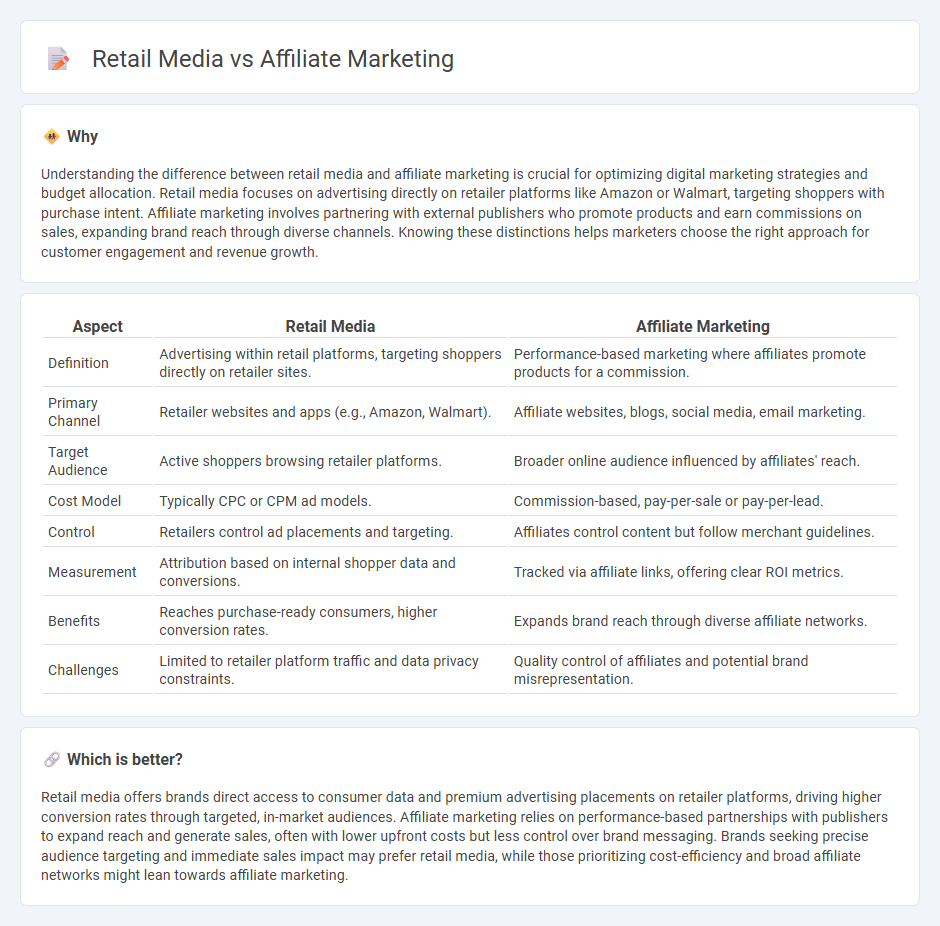
Retail media leverages retailers' digital properties to display targeted ads directly within shopping environments, enhancing purchase intent and driving measurable sales. Affiliate marketing uses a network of partners who promote products on their platforms in exchange for commissions, expanding brand reach through diverse online channels. Discover how these strategies can transform your marketing efforts and boost ROI.
Why it is important
Understanding the difference between retail media and affiliate marketing is crucial for optimizing digital marketing strategies and budget allocation. Retail media focuses on advertising directly on retailer platforms like Amazon or Walmart, targeting shoppers with purchase intent. Affiliate marketing involves partnering with external publishers who promote products and earn commissions on sales, expanding brand reach through diverse channels. Knowing these distinctions helps marketers choose the right approach for customer engagement and revenue growth.
Comparison Table
| Aspect | Retail Media | Affiliate Marketing |
|---|---|---|
| Definition | Advertising within retail platforms, targeting shoppers directly on retailer sites. | Performance-based marketing where affiliates promote products for a commission. |
| Primary Channel | Retailer websites and apps (e.g., Amazon, Walmart). | Affiliate websites, blogs, social media, email marketing. |
| Target Audience | Active shoppers browsing retailer platforms. | Broader online audience influenced by affiliates' reach. |
| Cost Model | Typically CPC or CPM ad models. | Commission-based, pay-per-sale or pay-per-lead. |
| Control | Retailers control ad placements and targeting. | Affiliates control content but follow merchant guidelines. |
| Measurement | Attribution based on internal shopper data and conversions. | Tracked via affiliate links, offering clear ROI metrics. |
| Benefits | Reaches purchase-ready consumers, higher conversion rates. | Expands brand reach through diverse affiliate networks. |
| Challenges | Limited to retailer platform traffic and data privacy constraints. | Quality control of affiliates and potential brand misrepresentation. |
Which is better?
Retail media offers brands direct access to consumer data and premium advertising placements on retailer platforms, driving higher conversion rates through targeted, in-market audiences. Affiliate marketing relies on performance-based partnerships with publishers to expand reach and generate sales, often with lower upfront costs but less control over brand messaging. Brands seeking precise audience targeting and immediate sales impact may prefer retail media, while those prioritizing cost-efficiency and broad affiliate networks might lean towards affiliate marketing.
Connection
Retail media and affiliate marketing are interconnected through their shared goal of driving conversions by leveraging consumer intent on shopping platforms. Retail media utilizes retailers' data to target ads directly within e-commerce environments, while affiliate marketing expands reach by rewarding partners for traffic and sales generated through referral links. This synergy enhances performance marketing strategies, boosting ROI by combining precise audience targeting with scalable promotional networks.
Key Terms
Commission Structure
Affiliate marketing typically operates on a performance-based commission structure, where affiliates earn a fixed percentage or a set fee for each sale or lead generated through their promotional efforts. Retail media relies on paid placements within retailer platforms, often with cost models such as cost-per-click (CPC) or cost-per-impression (CPM), rather than direct commissions from sales. Explore further to understand how these commission models impact marketing budgets and ROI strategies.
Attribution Model
Affiliate marketing relies heavily on last-click attribution, crediting the affiliate who drives the final conversion, which can oversimplify customer journeys. Retail media platforms often employ multi-touch attribution models to analyze the impact of various touchpoints across the consumer path within e-commerce ecosystems. Discover how advanced attribution models can optimize your marketing strategy by exploring their distinct applications.
Sponsored Product Placement
Sponsored Product Placement in affiliate marketing leverages influencer networks and content creators to promote products through personalized recommendations and targeted links, driving direct sales and commissions. Retail media involves brands paying retailers to feature their products prominently on e-commerce platforms, enhancing visibility through data-driven placement and consumer insights. Explore deeper strategies and performance metrics to maximize ROI in both Sponsored Product Placement models.
Source and External Links
Affiliate Marketing 101: What it is and How to Get Started - Affiliate marketing is a strategy where an affiliate earns commissions by promoting another company's products or services, involving three parties: the seller/product creator, the affiliate promoting the product, and the consumer who buys it.
Affiliate Marketing Guide: All You Need To Know (2025) - Affiliate marketing pays affiliates commissions for driving sales, leads, or other valuable actions through unique tracking links, and beginners can start by choosing a niche, platform, and affiliate programs while creating valuable content and building an audience.
Amazon.com Associates Central - Amazon's affiliate program allows content creators, publishers, and bloggers to monetize traffic by sharing Amazon products with their audience and earning commissions on qualifying purchases, with easy link-building tools and up to 10% commission rates.
 dowidth.com
dowidth.com